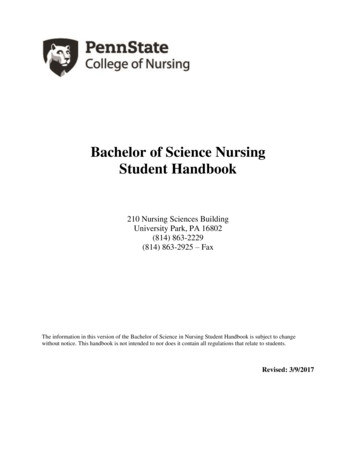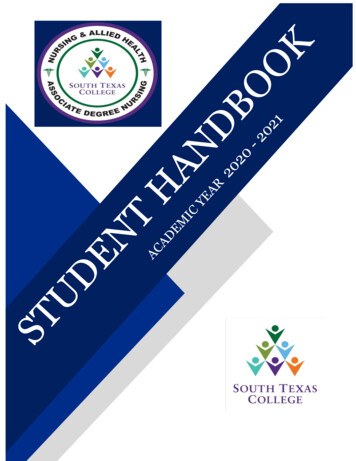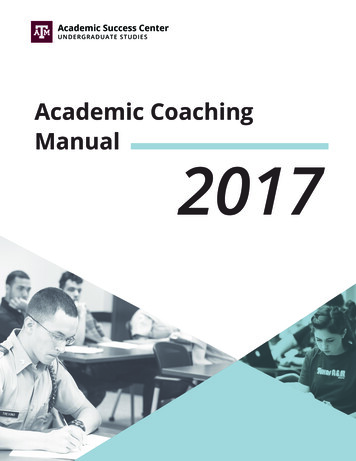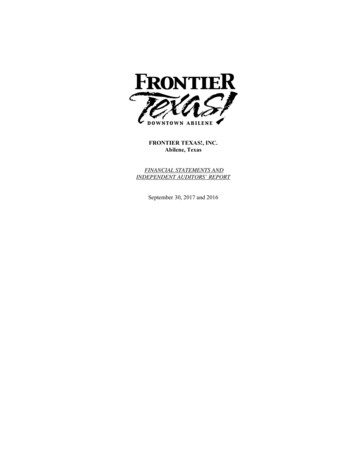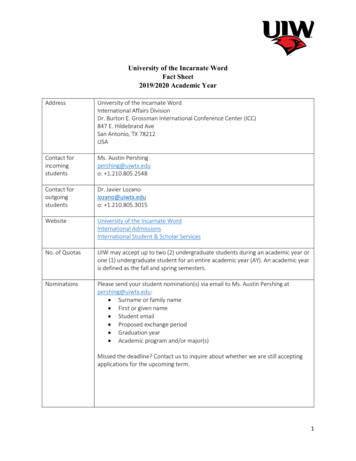
Transcription
2020–21 Texas Academic Performance Report(TAPR) GlossaryCover Page2021 Accountability Rating: Given the impact of COVID-19, all districts, open-enrollment charterschools, and campuses received a label of Not Rated: Declared State of Disaster unless the districtapplied for and received an Acceptable campus rating under the optional alternative evaluation forestablished by Senate Bill 1365. Acceptable campus ratings will be released with the final TAPR inJanuary 2022.Distinction Designations: Distinction designations were not awarded for 2021.2021 Special Education Determination Status (district TAPR only): This label represents an integrateddetermination level status based on an evaluation of each local educational agency’s (LEA) ResultsDriven Accountability (RDA) indicators in the special education program area and four FederallyRequired Elements (FREs), which include the State Performance Plan (SPP) compliance indicators 9, 10,11, 12, and 13; data integrity; uncorrected noncompliance; and financial audit findings. Each LEAreceives one of four special education determination levels (DLs):Meets RequirementsNeeds AssistanceNeeds InterventionNeeds Substantial InterventionFor additional information, please see the links below.General Information about RDA and SPP/APR:Results Driven Accountability (RDA): ability-rdaState Performance Plan and Annual Performance Report: logy for RDA and SPP/APR:2021 RDA Manual: https://tea.texas.gov/sites/default/files/19 0097 1005-1.pdfFFY 2019 SPP/APR Methodology: category &selected-year &state TexasData Reports for RDA and SPP/APR:SPP/APR Data Report: https://rptsvr1.tea.texas.gov/idea/index.htmlRDA Data Reports: ty-data-and-reportsTexas Education Agency Governance and Accountability Performance Reporting1 of 45
2020–21 Texas Academic Performance Report(TAPR) Glossary2021 Armed Services Vocational Aptitude Battery (ASVAB) Test (Career Exploration) (districts servinggrades 10–12): Senate Bill 1843 requires that each school year, each school district and open-enrollmentcharter school provide students in grades 10–12 the opportunity to take the ASVAB and consult with amilitary recruiter.PerformanceSTAAR: A comprehensive testing program for public school students in grades 3–8 or high schoolcourses with end-of-course (EOC) assessments. The STAAR program is designed to measure to whatextent a student has learned, understood, and is able to apply the concepts and skills expected at eachgrade level or after completing each course for which an EOC assessment exists. Each STAAR assessmentis linked directly to the Texas Essential Knowledge and Skills (TEKS). The TEKS are the state-mandatedcontent standards that describe what a student should know and be able to do upon completion of acourse. For more information on the TEKS, see the Texas Essential Knowledge and Skills website athttp://tea.texas.gov/curriculum/teks/.Other Important Information:STAAR (with and without accommodations) and STAAR Alternate 2. The TAPR and the TexasPerformance Reporting System (TPRS) include performance on STAAR and STAAR Alternate 2.Spanish STAAR. All STAAR assessments in grades 3, 4, and 5 are available in both English and Spanish.The TAPR and the TPRS include performance on the Spanish STAAR.Rounding of STAAR results. STAAR performance shown on the TAPR and TPRS is rounded to wholenumbers. For example, 49.877% is rounded to 50%; 49.4999% is rounded to 49%; and 59.5% isrounded to 60%.Masking. STAAR performance rates are masked when necessary to comply with FERPA. For moreinformation, see the Explanation of Masking /2021/masking.html.STAAR Performance (2020–21)The STAAR Performance section displays performance results by grade, subject and performance levelfor students in the accountability subset, which are students enrolled in the same district/campus onboth the snapshot date (PEIMS October snapshot) and the testing date. The STAAR Performance–AllStudents section of the TPRS displays STAAR performance by grade, subject, and performance level andincludes all students tested, regardless of whether they were in the accountability subset.STAAR:Grade 3 – reading and mathematicsGrade 4 – reading, mathematics, and writingGrade 5 – reading (for 2019, first and second administration cumulative), mathematics (for2019, first and second administration cumulative), and scienceGrade 6 – reading and mathematicsGrade 7 – reading, mathematics, and writingTexas Education Agency Governance and Accountability Performance Reporting2 of 45
2020–21 Texas Academic Performance Report(TAPR) GlossaryGrade 8 – reading (for 2019, first and second administration cumulative), mathematics (for2019, first and second administration cumulative), science, and social studiesEnd-of-Course (EOC):English IEnglish IIAlgebra IBiologyU.S. HistoryAccelerated Testers:SAT/ACTPercentage at Approaches Grade Level or Above. The percentage of assessments that met or exceededthe Approaches Grade Level standard.Percentage at Meets Grade Level or Above. The percentage of assessments that met or exceeded theMeets Grade Level standard.Percentage at Masters Grade Level. The percentage of assessments that met the Masters Grade Levelstandard.Progress (Academic Growth and STAAR Progress Measure) (2018–19)Due to the lack of 2020 STAAR results, Academic Growth was not calculated for 2021; 2018 and 2019data are shown.School Progress Domain—Academic Growth Score. Growth score awarded in School Progress, Part A:Academic Growth for improving performance year over year as measured by STAAR progressmeasures and performance levels on STAAR.Bilingual Education/ESL (2020–21)Bilingual Education (BE): Dual-language program that enables emergent bilingual (EB) students/Englishlearners (ELs) to become proficient in listening, speaking, reading, and writing in the English languagethrough the development of literacy and academic skills in the primary language and English. Thiscategory includes the following: BE Trans Early Exit. Bilingual program model in which students identified as EB students/ELs areserved in both English and another language and are prepared to meet reclassification criteria tobe successful in English-only instruction not earlier than two or later than five years after thestudent enrolls in school. BE Trans Late Exit. Bilingual program model in which students identified as EB students/ELs areserved in both English and another language and are prepared to meet reclassification criteria tobe successful in English-only instruction not earlier than six or later than seven years after thestudent enrolls in school.Texas Education Agency Governance and Accountability Performance Reporting3 of 45
2020–21 Texas Academic Performance Report(TAPR) Glossary BE Dual Two-Way. Bilingual/biliteracy program model in which students identified as EBstudents/ELs are integrated with non-EB/non-EL students and are served in both English andanother language and are prepared to meet reclassification criteria to be successful in Englishonly instruction not earlier than six or later than seven years after the student enrolls in school.This model provides ongoing instruction in literacy and academic content in English and anotherlanguage with at least half of the instruction delivered in the non-English program language forthe duration of the program. BE Dual One-Way. Bilingual/biliteracy program model in which students identified as EBstudents/ELs are served in both English and another language and are prepared to meetreclassification criteria to be successful in English-only instruction not earlier than six or laterthan seven years after the student enrolls in school. This model provides ongoing instruction inliteracy and academic content in the students' primary language as well as English, with at leasthalf of the instruction delivered in the students' primary language for the duration of theprogram.English as a Second Language (ESL): An English acquisition program that enables EB students/ELs tobecome proficient in listening, speaking, reading, and writing in the English language through theintegrated use of second language acquisition methods. This category includes the following: ESL Content-Based. An English acquisition program that serves students identified as EBstudents/ELs through English instruction by a teacher appropriately certified in ESL under TEC,§29.061(c), through English language arts and reading, mathematics, science, and social studies. ESL Pull-Out. An English program that serves students identified as EB students/ELs throughEnglish instruction provided by an appropriately certified ESL teacher under the TEC, §29.061(c),through English language arts and reading. Instruction shall be provided by the ESL teacher in apull-out or inclusionary delivery model.Alternative Language Program (ALP): An alternative language program provided to EB students/ELs forwhom the LEA does not have the appropriately certified teachers for the required bilingual education orESL program for the current school year. This category includes the following: ALP Bilingual (Exception). An alternative language program to the required bilingual education(BE) program approved by the TEA for the current school year due to the LEA’s submission of abilingual education exception application. ALP ESL (Waiver). An alternative language program to the required English as a second language(ESL) program approved by the TEA for the current school year due to the LEA’s submission ofan ESL waiver application.Emergent Bilingual (EB) Students/English Learners (EL): The count and percentage of students whoseprimary language is other than English and who are in the process of acquiring English. As a result of the87th Texas Legislature, the term “emergent bilingual student” replaced the term of “limited Englishproficient (LEP) student” used in the Texas Education Code (TEC), Chapter 29, Subchapter B, and thus,will be changing the term of “English learner (EL)” used in 19 TAC Chapter 89, Subchapter BB. Theseterms describe the same group of Texas students. In the revised Texas Education Data Standards (TEDS),Texas Education Agency Governance and Accountability Performance Reporting4 of 45
2020–21 Texas Academic Performance Report(TAPR) Glossarythe terms of “emergent bilingual” and “English learner” have been bridged as EB/EL. The term “Englishlearner” is still used in federal regulations and guidance. This category includes: EB/EL with Parental Denial. Students identified as EB students/ELs whose parents have deniedall bilingual and ESL program services. Never EB/EL. Students who have never been identified as EB students/ELs (non-EBstudents/non-ELs). Total EB/EL (Current). Students currently identified as EB students/ELs, including those served ina standard or alternative bilingual or ESL program as well as those with a parental denial ofservices. Monitored & Former EB/EL. Students who were once identified as EB students/ELs but havereclassified as English proficient, including students within their four years of state and federalmonitoring and those beyond monitoring years.STAAR Participation (2020–21)The percentage of students who were administered a STAAR assessment, STAAR Alternate 2, TexasEnglish Language Proficiency Assessment System (TELPAS), TELPAS Alternate, and/or an SAT/ACT. Thedetails on the participation categories are as follows:Assessment Participant: 1) number of answer documents with a score code of S, 2) number ofSTAAR Alternate 2 testers with a score code of N, 3) number of A or O reading answerdocuments with a scored TELPAS or TELPAS Alternate assessment, 4) number of A or Omathematics answer documents with a scored TELPAS or TELPAS alternate assessment foryear 1-5 asylee/refugees and students with interrupted formal education (SIFEs), and 5)number of accelerated testers’ EBRW SAT, ELA ACT assessments, ACT science, andmathematics SAT and ACT assessments. Included in Accountability: scored answer documents Not included in Accountability: answer documents counted as participants but notincluded in performance calculations Mobile: answer documents were excluded because the students enrolled in thedistrict or campus after the TSDS PEIMS fall snapshot. Other Exclusions. The following answer documents were excluded fromperformance calculations: Answer documents for students who were tested only on the TELPAS/TELPASAlternate or TELPAS/TELPAS Alternate plus STAAR assessments with score codesof A or O. Answer documents of students who are either EB students/ELs who have beenin school in the U.S. for one year. Answer documents of STAAR Alternate 2 testers with a score code of N.Not Tested: answer documents with score codes A or O or accelerated testers without anSAT/ACT assessmentTexas Education Agency Governance and Accountability Performance Reporting5 of 45
2020–21 Texas Academic Performance Report(TAPR) Glossary Absent: answer documents with score code A Other: answer documents with score code O The denominator for participation is the sum of these five categories: Included inAccountability, Mobile, Other Exclusions, and Not Tested (Absent and Other). STAARParticipation Rate is rounded to a whole number. For example, 94.49% is rounded to94%. Small values may show as zero: 0.4% is rounded to 0%, and 0.6% is rounded to 1%.(Data source: STAAR and TELPAS File)Accelerated Testers: SAT/ACT results for students who completed STAAR end-of-course (EOC)assessments while in middle school.Attendance and GraduationAttendance, Graduation, and Dropout Rates (2020–21)Attendance Rate: The percentage of days that students were present. The rate for 2019–20 is based onstudent attendance through the fourth six weeks due to the Covid-19 pandemic. Only students in grades1–12 are included in the calculation. Attendance is calculated as follows:total number of days that students in grades 1–12 were present during the 2019–20 schoolyeartotal number of days that students in grades 1–12 were in membership during the 2019–20school year(Data source: PEIMS 42400)Chronic Absenteeism: The unduplicated number of K–12 students enrolled for at least 10 days andabsent for 10 percent or more days. Chronic Absenteeism is calculated as follows:total number of K–12 students enrolled for at least 10 days and absent for 10 percent ormore days during the 2019–20 school yeartotal number of K–12 students enrolled for at least 10 days during the 2019–20 school year(Data source: PEIMS 42400)Annual Dropout Rate: The percentage of students who drop out of school during a school year. Annualdropout rates are shown for districts and campuses that serve grades 7–8 and/or 9–12. State lawprohibits including a student who meets any of the following criteria from campus and district annualdropout rate calculations: Is ordered by a court to attend a high school equivalency certificate program but has not earneda high school equivalency certificate Was previously reported to the state as a dropout Was in attendance but not in membership for purposes of average daily attendance (i.e.,students for whom school districts are not receiving state Foundation School Program [FSP]funds)Texas Education Agency Governance and Accountability Performance Reporting6 of 45
2020–21 Texas Academic Performance Report(TAPR) Glossary Was initially enrolled in a school in the United States in any grade 7 through 12 as an unschooledrefugee or asylee as defined by TEC §39.027(a-1) Attends a district exclusively as a function of having been detained at a county detention facilityand is not otherwise a student of the district in which the facility is located or is being providedservices by an open-enrollment charter school exclusively as the result of having been detainedat the facility Is incarcerated in a state jail or federal penitentiary as an adult or as a person certified to standtrial as an adult Is a student in a Texas Juvenile Justice Department facility or residential treatment facilityserved by a Texas public school district Is at least 18 years of age as of September 1 and has satisfied the credit requirements for highschool graduation; has not completed his or her individualized education program (IEP); and isenrolled and receiving IEP servicesAnnual Dropout Rate (Gr 7–8). This includes only grades 7 and 8. It is calculated as follows:number of dropouts in grades 7 and 8 during the 2019–20 school yearnumber of students in grades 7 and 8 in attendance at any time during the 2019–20 school yearAnnual Dropout Rate (Gr 9–12). This includes grades 9 through 12. It is calculated as follows:number of dropouts in grades 9–12 during the 2019–20 school yearnumber of students in grades 9–12 in attendance at any time during the 2019–20 school yearBoth annual dropout rates appear on campus, district, region, and state TAPRs. The state and regionannual dropout rates that are reported on district and campus TAPRs, however, are calculated withoutthe exclusions required for campus and district calculations.Note that with all annual dropout rate calculations, a cumulative count of students is used in thedenominator. This method for calculating the dropout rate neutralizes the effect of mobility by includingin the denominator every student ever reported in attendance at the district or campus throughout theschool year, regardless of length of enrollment. For a more complete description of dropout rates andexclusions, see the Secondary School Completion and Dropouts in Texas Public Schools, 2019–20 reports,available on the TEA website at http://tea.texas.gov/acctres/dropcomp index.html.For detailed information on data sources, see Appendix H in the 2021 Accountability Manual (Datasource: PEIMS 40203, 40110, 42400, and 42500)Longitudinal Rates: The status of a group (cohort) of students after four years in high school (4-YearLongitudinal Rate), after five years in high school (5-Year Extended Longitudinal Rate), or after six yearsin high school (6-Year Extended Longitudinal Rate).For the 4-Year Longitudinal Rate, the cohort consists of students who first attended ninth grade in2016–17. They are followed through their expected graduation with the Class of 2020.Texas Education Agency Governance and Accountability Performance Reporting7 of 45
2020–21 Texas Academic Performance Report(TAPR) GlossaryFor the 5-Year Extended Longitudinal Rate, the cohort consists of students who first attended ninthgrade in 2015–16. They are followed for five years and included if they graduated within a year aftertheir expected graduation with the Class of 2019.For the 6-Year Extended Longitudinal Rate, the cohort consists of students who first attended ninthgrade in 2014–15. They are followed for six years and included if they graduated within two years aftertheir expected graduation with the Class of 2018.Additional Information on Cohorts:A student transfers into a campus, district, or state cohort when he or she moves into the cohortfrom another high school in Texas, from another district in Texas, or from out of state.A student transfers out of a campus or district cohort when he or she moves to another public highschool in Texas or moves to another district in Texas. Note that these students are transferred intothe cohort of the high school or district to which they moved. There are also students who move outof state or out of the country and students who transfer to private schools or who are homeschooled. These types of transfer students cannot be tracked and are not included in longitudinalrate calculations.A student does not change cohorts if he or she repeats or skips a grade. A student who begins withthe 2016–17 ninth-grade cohort remains with that cohort. A student who started the ninth grade in2016–17 but takes 5 years to graduate (i.e., graduates in May 2021) is still part of the 2020 cohort; heor she is not switched to the 2021 cohort. This student would be considered a continuing student andcounted as part of the Continued HS number for the Class of 2020. This is also true for the five-yearand six-year extended longitudinal cohorts.There are four student outcomes used in computing each longitudinal rate:4-Year Longitudinal Rate(1) Graduated: The percentage who received their high school diploma in four years or fewer byAugust 31, 2020 for the 2020 cohort.number of students from the cohort who received a high school diploma byAugust 31, 2020number of students in the 2020 cohort*(2) Received TxCHSE: For the 2020 cohort, the percentage who received a Texas high schoolequivalency certificate by August 31, 2020. It is calculated as follows:number of students from the cohort who received a TxCHSE by August 31, 2020number of students in the 2020 cohort*Texas Education Agency Governance and Accountability Performance Reporting8 of 45
2020–21 Texas Academic Performance Report(TAPR) Glossary(3) Continued High School: The percentage of the 2020 cohort still enrolled as students in the fall ofthe 2020–21 school year. It is calculated as follows:number of students from the cohort who were enrolled in the fall of the 2020–21 school yearnumber of students in the 2020 cohort*(4) Dropped Out: The percentage of the 2020 cohort who dropped out and did not return by the fallof the 2020–21 school year. It is calculated as follows:number of students from the cohort who dropped out before fall of the 2020–21 schoolyearnumber of students in the 2020 cohort*(5) Graduates & TxCHSE: The percentage of graduates and TxCHSE recipients in the 2020 cohort.It is calculated as follows:number of students from the 2020 cohort who received a high school diploma by August 31,2020 plus number of students from the cohort who received a TxCHSE by August 31, 2020number of students in the 2020 cohort*(6) Graduates, TxCHSE & Continuers: The percentage of graduates, TxCHSE recipients, andcontinuers in the 2020 cohort. It is calculated as follows:number of students from the cohort who received a high school diploma by August 31, 2020plusnumber of students from the cohort who received a TxCHSE by August 31, 2020plusnumber of students from the cohort who were enrolled in the fall of the 2020–21 school yearnumber of students in the 2020 cohort*5-Year Extended Longitudinal Rate(1) Graduated: The percentage who received their high school diploma by August 31, 2020, for the2019 cohort. It is calculated as follows:number of students from the cohort who received a high school diploma by August 31, 2020number of students in the 2019 cohort*Texas Education Agency Governance and Accountability Performance Reporting9 of 45
2020–21 Texas Academic Performance Report(TAPR) Glossary(2) Received TxCHSE: For the 2019 cohort, the percentage who received a TxCHSE certificate byAugust 31, 2020. It is calculated as follows:number of students from the cohort who received a TxCHSE by August 31, 2020number of students in the 2019 cohort*(3) Continued High School: The percentage of the 2019 cohort still enrolled as students in the fall ofthe 2020–21 school year. It is calculated as follows:number of students from the cohort who were enrolled in the fall of the 2020–21 school yearnumber of students in the 2019 cohort*(4) Dropped Out: The percentage of the 2019 cohort who dropped out and did not return by the fallof the 2020–21 school year. It is calculated as follows:number of students from the cohort who dropped out before fall of the 2020–21 school yearnumber of students in the 2019 cohort*(5) Graduates & TxCHSE: The percentage of graduates and TxCHSE recipients in the 2019 cohort. Itis calculated as follows:number of students from the cohort who received a high school diploma by August 31, 2020plusnumber of students from the cohort who received a TxCHSE by August 31, 2020number of students in the 2019 cohort*(6) Graduates, TxCHSE & Continuers: The percentage of graduates, TxCHSE recipients, andcontinuers in the 2019 cohort. It is calculated as follows:number of students from the cohort who received a high school diploma by August 31, 2020plusnumber of students from the cohort who received a TxCHSE by August 31, 2020plusnumber of students from the cohort who were enrolled in the fall of the 2020–21 school yearnumber of students in the 2019 cohort*Texas Education Agency Governance and Accountability Performance Reporting10 of 45
2020–21 Texas Academic Performance Report(TAPR) Glossary6-year Extended Longitudinal Rate(1) Graduated: The percentage who received their high school diploma by August 31, 2020, for the2018 cohort. It is calculated as follows:number of students from the cohort who received a high school diploma by August 31, 2020number of students in the 2018 cohort*(2) Received TxCHSE: For the 2018 cohort, the percentage who received a TxCHSE certificate byAugust 31, 2020. It is calculated as follows:number of students from the cohort who received a TxCHSE by August 31, 2020number of students in the 2018 cohort*(3) Continued High School: The percentage of the 2018 cohort still enrolled as students in the fall ofthe 2020–21 school year. It is calculated as follows:number of students from the cohort who were enrolled in the fall of the 2020–21 school yearnumber of students in the 2018 cohort*(4) Dropped Out: The percentage of the 2018 cohort who dropped out and did not return by the fallof the 2020–21 school year. It is calculated as follows:number of students from the cohort who dropped out before fall of the 2020–21 school yearnumber of students in the 2018 cohort*(5) Graduates & TxCHSE. The percentage of graduates and TxCHSE recipients in the 2018 cohort. Itis calculated as follows:number of students from the cohort who received a high school diploma by August 31, 2020plusnumber of students from the cohort who received a TxCHSE by August 31, 2020number of students in the 2018 cohort*Texas Education Agency Governance and Accountability Performance Reporting11 of 45
2020–21 Texas Academic Performance Report(TAPR) Glossary(6) Graduates, TxCHSE & Continuers. The percentage of graduates, TxCHSE recipients, andcontinuers in the 2018 cohort. It is calculated as follows:number of students from the cohort who received a high school diploma by August 31, 2020plusnumber of students from the cohort who received a TxCHSE by August 31, 2020plusnumber of students from the cohort who were enrolled in the fall of the 2020–21 school yearnumber of students in the 2018 cohort**The cohort in the denominator of the formulas shown above includes those students whograduated, continued in school, received a TxCHSE, or dropped out. It does not include dataerrors or leavers with the leaver reason codes 03, 16, 24, 60, 66, 78, 81, 82, 83, 85, 86, 87, 88, 89or 90. See Annual Dropout Rate for a list of all the exclusions mandated by state statute fordistricts and campuses.The graduation, continuation, TxCHSE recipient, and dropout rates sum to 100% (some totals maynot equal exactly 100% due to rounding). Students served through special education who graduatewith an individualized education program (IEP) are included as graduates.Additional Information about Federal Graduation RatesIn addition to the detailed breakdown of the four-, five- and six-year longitudinal rates, the districtand campus reports show federal graduation rates for the following:(1) 4-Year Federal Graduation Rate. Cohort of students who first attended ninth grade in 2016–17.They are followed through their expected graduation with the Class of 2020. It is calculated asfollows:number of students from the cohort who received a high school diploma by August 31, 2020number of students in the 2020 cohort **A student in a Texas Juvenile Justice Department facility or residential treatment facility served by aTexas public school district is excluded from district and campus graduation rates calculated for federalaccountability purposes. Students served by special education who graduate with an individualizededucation program (IEP) are included as graduates.For further information on these rates, see the report Secondary School Completion and Dropouts inTexas Public Schools 2019–20. (Data source: PEIMS 40203 and Texas Certificate of High SchoolEquivalency Information File)Graduation Program: The percentage of students who graduated under one of the following programs:RHSP/DAP Graduates (Longitudinal Rate) (Class of 2020) The percentage of graduates who, after fouryears, satisfied the course requirements for the Recommended High School Program orDistinguished Achievement Program.Texas Education Agency Governance and Accountability Performance Reporting12 of 45
2020–21 Texas Academic Performance Report(TAPR) Glossarynumber of graduates in the Class of 2020 who complete a 4-year RHSP or DAPnumber of graduates in the Class of 2020 with reported graduation plans(excludes graduates with FHSP degree plans)FHSP-E Graduates (Longitudinal Rate) The percentage of graduates who, after four years, satisfiedthe course requirements for the Foundation High School Program with an endorsement.number of graduates in the Class of 2020 who complete a 4-year FHSP-Enumber of graduates in the Class of 2020 with reported FHSP graduation plansFHSP-DLA Graduates (Longitudinal Rate) The percentage of graduates who, after four years, satisfiedthe course requirements for the Foundation High School Program at the distinguished level ofachievement.number of graduates in the Class of 2020 who complete a 4-year FHSP-DLAnumber of graduates in the Class of 2020 with reported FHSP graduation plansRHSP/DAP/FHSP-E/FHSP-DLA Graduates (Longitudinal Rate) The percentage of gr
Grade 3 – reading and mathematics . Grade 4 – reading, mathematics, and writing . Grade 5 – reading (for 2019, first and second administration cumulative), mathematics (for 2019, first and second administration cumulative), and science . Grade 6 – reading and mathematics . Grade

